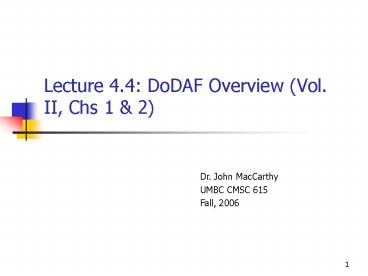Lecture 4.4: DoDAF Overview (Vol. II, Chs 1 PowerPoint PPT Presentation
1 / 12
Title: Lecture 4.4: DoDAF Overview (Vol. II, Chs 1
1
Lecture 4.4 DoDAF Overview (Vol. II, Chs 1 2)
Dr. John MacCarthy UMBC CMSC 615 Fall, 2006
2
Agenda
- Overview
3
Overview (1.1) and Purpose (1.2)
- DoDAF provides a common approach for DoD
architecture description development,
presentation, and integration - Supports Requirements Development
- Complete
- Consistent
- Allocated to Components
- Supports Design Development
- Complete
- Consistent
- Meets Requirements
- Definitions
- Architecture refers to both
- An architecture description
- An architecture implementation
- Architecture Description is a representation of
a defined domain in terms of constituent parts,
what those parts do, how the parts relate to each
other and to the environment and the rules and
constraints governing them - Architecture Implementation is a real
implementation of capabilities and assets in the
field - Integrated Architecture is an architecture
description that ahs integrated OVs, SVs and TVs
4
Architecture Views (2.1)
- The Framework defines three views
- Operational View (OV) describes tasks,
activities, operational elements, and information
exchanges required to accomplish DoD Missions,
i.e., enterprise mission aspects. - System View (SV) describes systems and
interconnections providing for, or supporting,
DoD functions. It associates systems resources to
the OV. - Technical Standards View (TV) provides the
technical systems implementation guidelines upon
which engineering specifications are based,
common building blocks are established, and
product lines are developed, e.g., policies and
technical standards. - All View (AV) products are those provide
overarching information describing the
architecture plans, scope, and definitions
- Each View is composed of sets of architecture
data elements that are depicted via graphic,
tabular, and textual products. - The Core Architecture Data Model (CADM) defines
the entities and relationships for architecture
data. - DoDAF recognizes that the term Architecture is
overloaded. As such, it divides the term into
different views and products (for each view).
5
Architecture Products (2.2)
6
Architecture Products (2.2) All Views,
Operational Views and Technical Views
7
Architecture Products (2.2) Systems Views
8
Architecture Data Elements (2.3)
- Architecture Data Elements (ADEs) are the
underlying basic elements that comprise the
architecture (examples will be provided later) - These ADEs are captured in the a Architecture
Data Model that is specific to each AV, OV, SV,
or TV graphics (examples will be provided later) - The All-DoD Core Architecture Data Model (CADM)
specifies the ADE fields for each View
9
Architecture Product Development (2.4)
- Supports both Structured Analysis (IDEF) and UML
methodologies - Most products may be decomposed to multiple
levels - Decomposition should be to the level required for
the stated objective (user) - Products should be developed iteratively (per SE
Process) - Templates should be developed
10
Integrated Dictionary Legend
- Reference ID
- Function/Activity A1.X.y
- System/Subsystem Element C1.X.y
- External System/Subsystem Element ESX.Y
- Rule Model RM1.X.y
- Data Entity (DE) DEX.y
- Acronym
- Term
- Definitions
- Functions should indicate I/O Des and Rule Models
- System/Subsystem Elements should include
alllocated Functions - DEs should include list of DAs
- DAs should include data type, visibility, and
ranges. - RMs should include reference to functions and DEs
- Entry Types
- Operational Node (ON)
- Operational Element (OE)
- System (Sys)
- Subsystem Element (SE)
- Actor (Actor)
- External System (ES)
- External Subsystem Element (ESE)
- Function/Activity (Fnc)
- Rule Model (RM)
- State (State)
- Data Entity (DE)
- Data Attribute (DA)
11
AV-2 Integrated Dictionary -WBRS Example
12
Conclusions
- AV-1 and AV-2 are essential products for every
architecture - AV-1 is usually developed in a Word document
- Initially one may want to develop the AV-2 in
Word or Excel until you figure out the desired
format or until a CASE Architecture Tool is
selected.

